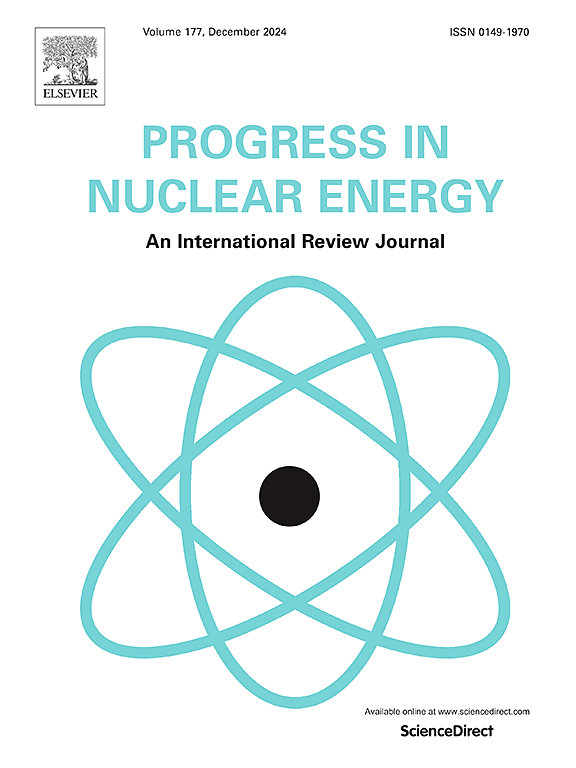A neutronic model to find promising candidates as burnable poisons in fast reactors
IF 3.2
3区 工程技术
Q1 NUCLEAR SCIENCE & TECHNOLOGY
引用次数: 0
Abstract
Small modular liquid-metal-cooled fast reactors may require dedicated provisions to reach very long core lifetime, or to reduce the reactivity swing if minimizing control requirements is needed. In such cases, the use of burnable poisons may be a necessary route. Unfortunately, to date very few materials are known that may be used as burnable poisons in fast reactors. Goal of this paper is therefore to propose a model by which the expected neutronic behavior of a candidate burnable poison material in fast spectrum can be estimated without the need for extensive neutronic calculations, for which a detailed description of the system in terms of materials and geometry would be required. The neutronic behavior of a material is estimated by considering separately its performance in terms of poisonousness, defined as the ability to provide enough negative reactivity to compensate for the initial excess reactivity of the fuel, from its performance in terms of burnability, defined as the ability to balance in time the reactivity change due to fuel depletion. Although the values calculated by the model equations do not have physical meaning per se, they can be used to compare different materials with each other in order to make a preliminary assessment of their neutronic behavior. The model was first tested with seven candidates (Eu2O3, Gd2O3, Dy2O3, Er2O3, NpO2, AmO2 and B4C), and then assessed against the results obtained from simulations with MCNP6.1 for a lead fast reactor fuel assembly with UO2 enriched in 235U at 19.75 wt% in which, one at a time, the various candidates have been added. Despite some small differences from the simulations especially at low burnups, the comparison confirmed the prediction capability of the model up to a poison content of 10 at.%.
在快堆中寻找有希望的候选可燃毒物的中子模型
小型模块化液态金属冷却快堆可能需要专门的装置来达到很长的堆芯寿命,或者在需要最小化控制要求的情况下减少反应性摆动。在这种情况下,使用可燃毒物可能是必要的途径。不幸的是,迄今为止,已知的可在快堆中用作可燃毒物的材料很少。因此,本文的目标是提出一个模型,通过该模型可以估计候选可燃有毒材料在快速光谱中的预期中子行为,而不需要大量的中子计算,为此需要在材料和几何方面对系统进行详细描述。材料的中子行为是通过分别考虑其毒性性能和可燃性性能来估计的,毒性性能定义为提供足够的负反应性以补偿燃料最初的过度反应性的能力,可燃性性能定义为及时平衡燃料耗尽引起的反应性变化的能力。虽然模型方程计算的值本身不具有物理意义,但它们可以用来比较不同材料,以便对它们的中子行为进行初步评估。该模型首先用七种候选物质(Eu2O3、Gd2O3、Dy2O3、Er2O3、NpO2、AmO2和B4C)进行了测试,然后用MCNP6.1对一个UO2富集量为19.75% (wt%)的快堆燃料组件进行了模拟,每次添加一种候选物质。尽管与模拟有一些小的差异,特别是在低燃烧时,比较证实了该模型的预测能力高达10 at.%的毒物含量。
本文章由计算机程序翻译,如有差异,请以英文原文为准。
求助全文
约1分钟内获得全文
求助全文
来源期刊

Progress in Nuclear Energy
工程技术-核科学技术
CiteScore
5.30
自引率
14.80%
发文量
331
审稿时长
3.5 months
期刊介绍:
Progress in Nuclear Energy is an international review journal covering all aspects of nuclear science and engineering. In keeping with the maturity of nuclear power, articles on safety, siting and environmental problems are encouraged, as are those associated with economics and fuel management. However, basic physics and engineering will remain an important aspect of the editorial policy. Articles published are either of a review nature or present new material in more depth. They are aimed at researchers and technically-oriented managers working in the nuclear energy field.
Please note the following:
1) PNE seeks high quality research papers which are medium to long in length. Short research papers should be submitted to the journal Annals in Nuclear Energy.
2) PNE reserves the right to reject papers which are based solely on routine application of computer codes used to produce reactor designs or explain existing reactor phenomena. Such papers, although worthy, are best left as laboratory reports whereas Progress in Nuclear Energy seeks papers of originality, which are archival in nature, in the fields of mathematical and experimental nuclear technology, including fission, fusion (blanket physics, radiation damage), safety, materials aspects, economics, etc.
3) Review papers, which may occasionally be invited, are particularly sought by the journal in these fields.
 求助内容:
求助内容: 应助结果提醒方式:
应助结果提醒方式:


